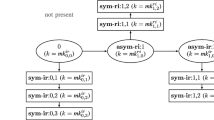Abstract
Our goal is to design encryption schemes for mass distribution of data , which enable to (1) deter users from leaking their personal keys, (2) trace the identities of users whose keys were used to construct illegal decryption devices, and (3) revoke these keys as to render the devices dysfunctional. We start by designing an efficient revocation scheme, based on secret sharing. It can remove up to t parties, is secure against coalitions of up to t users, and is more efficient than previous schemes with the same properties. We then show how to enhance the revocation scheme with traitor tracing and self-enforcement properties. More precisely, how to construct schemes such that (1) each user’s personal key contains some sensitive information of that user (e.g., the user’s credit card number), in order to make users reluctant to disclose their keys. (2) An illegal decryption device discloses the identity of users that contributed keys to construct the device. And, (3) it is possible to revoke the keys of corrupt users. For the last point, it is important to be able to do so without publicly disclosing the sensitive information.
Similar content being viewed by others
References
Anzai, J., Matsuzaki, N., Matsumoto, T.: A quick group key distribution scheme with entity revocation. Adv. in Cryptology—Asiacrypt’99. LNCS 1716, pp. 333–347. Springer, Berlin (1999)
Blakley G.R.: Safeguarding cryptographic keys. AFIPS Conference Proceedings 48, 313–317 (1979)
Boneh, D.: The decision diffie-hellman problem. In Proceedings of the Third Algorithmic Number Theory Symposium. LNCS Vol. 1423, pp. 48–63. Springer, Berlin (1998)
Boneh, D., Franklin, M.: An efficient public key traitor tracing scheme. In: Adv. in Cryptology—Crypto ’99, Springer- LNCS 1666 (1999), pp. 338–353, and a full version available at http://crypto.stanford.edu/~dabo/pubs.html
Boneh, D., Shaw, J.: Collusion-secure fingerprinting for digital date. In: Proceedings of Advances in Cryptology—Crypto ’95, pp. 452–465 (1995)
Canetti, R., Garay, J., Itkis, G., Micciancio, D., Naor, M., Pinkas, B.: Multicast security: a taxonomy and some efficient constructions. In: Proceedings of INFOCOM ’99, vol. 2, pp. 708–716. New York, NY, March (1999)
Canetti, R., Malkin, T., Nissim, K.: Efficient communication-storage tradeoffs for multicast encryption. In: Proceedings of Advances in Cryptology—Eurocrypt ’99. LNCS 1592, pp. 459–474. Springer, Berlin (1999)
Chor, B., Fiat, A., Naor, M.: Tracing traitors. In: Proceedings of Advances in Cryptology—Crypto ’94. LNCS vol. 839, pp. 257–270. Springer, Berlin (1994)
Chor B., Fiat A., Naor M., Pinkas B.: Tracing traitors. IEEE Trans. Inf. Theor. 46(3), 893–910 (2000)
Cramer, R., Shoup, V.: A practical public key cryptosystem provably secure against adaptove chosen ciphertext attacks. In: Proceedings of Advances in Cryptology—Crypto ’98. LNCS 1462, pp. 13–25. Springer, Berlin (1998)
Cohen H.: A Course in Computational Algebraic Number Theory. Springer, Berlin (1996)
Cox, I., Kilian, J., Leighton, T., Shamoon, T.: A secure, robust watermark for multimedia. Information Hiding Workshop, Cambridge, UK. LNCS 1174, pp. 185–206. Springer, Berlin (1996)
Diffie W., Hellman M.E.: New directions in cryptography. IEEE Trans. Inf. Theor. 22, 644–654 (1976)
Dwork, C., Lotspiech, J., Naor, M.: Digital signets: self-enforcing protection of digital information. In: 28th Symposium on the Theory of Computation, pp. 489–498 (1996)
ElGamal, T.: A public key cryptosystem a signature scheme based on discrete logarithms. In: Proceedings of Advances in Cryptology—Crypto ’84. LNCS 196, pp. 10–18. Springer, Berlin (1985)
Feldman, P.: A practical scheme for non-interactive verifiable secret sharing. In: Proceedings of 28th IEEE Symposium on Foundations of Computer Science, pp. 427–437 (1987)
Fiat, A., Naor, M.: Broadcast encryption. Advances in Cryptology–CRYPTO ’93. LNCS 773, pp. 480–491. Springer, Berlin (1994)
Gafni, E., Staddon, J., Yin, Y.L.: Efficient methods for integrating traceability and broadcast encryption. In: Proceedings of Advances in Cryptology—Crypto ’99. LNCS 1666, pp. 372–387. Springer, Berlin (1999)
Goldreich O., Goldwasser S., Micali S.: How to construct random functions. J. ACM 33, 792–807 (1986)
Kiayias, A., Yung, M.: Self protecting pirates and black-box traitor tracing. In: Adv. in Cryptology—Crypto ’2001. LNCS 2139, pp. 63–79. Springer, Berlin (2001)
Kumar, R., Rajagopalan, S., Sahai, A.: Coding constructions for blacklisting problems without computational assumptions. Adv. in Cryptology—Crypto ’99. LNCS 1666, pp. 609–623. Springer, Berlin (1999)
Kurosawa, K., Desmedt, Y.: Optimum traitor tracing and asymmetric schemes. In: Advances in Cryptology–Eurocrypt ’98. LNCS 1403, pp. 145–157. Springer, Berlin (1998)
Luby M.: Pseudo-Randomness and Applications. Princeton University Press, NJ (1996)
MacWilliams F.J., Sloane N.J.A.: The Theory of Error-Corecting Codes. North Holland, Amsterdam (1977)
Menezes A.J., van Oorschot P.C., Vanstone S.A.L.: Handbook of Applied Cryptography. CRC Press, Boca Raton (1996)
Naor, D., Naor, M., Lotspiech, J.B.: Revocation and tracing schemes for stateless receivers. In: Proceedings of Advances in Cryptology—Crypto ’01. LNCS 2139, pp. 41–62. Springer, Berlin (2001)
Naor, M., Pinkas, B.: Threshold traitor tracing. In: Proceedings of Advances in Cryptology—Crypto ’98. LNCS 1462, pp. 502–517. Springer, Berlin (1998)
Naor, M., Reingold, O.: Number-theoretic constructions of efficient pseudo-random functions. In: Proceeding of 38th IEEE Symposium on Foundations of Computer Science, pp. 458–467 (1997)
Shamir A.: How to share a secret. Comm. ACM 22(11), 612–613 (1979)
Haber, S., Pinkas, B.: Combining Public Key Cryptosystems. In: Proceedings of the ACM Computer and Security Conference, Nov (2001)
Stinson, D.R., Wei, R.: Key preassigned traceability schemes for broadcast encryption, SAC’98. LNCS 1556, Springer, Berlin (1998)
Stinson D.R., Wei R.: Combinatorial properties and constructions of traceability schemes and frameproof codes. SIAM J Discret. Math. 11(1), 41–53 (1998)
Wallner, D.M., Harder, E.J., Agee, R.C.: Key Management for Multicast: Issues and Architectures, Internet Request for Comments 2627, June, 1999. Available: ftp.ietf.org/rfc/rfc2627.txt
Welch, L.R., Berlekamp, E.R.: Error Correction for Algebraic Blockcodes, U.S. Patent 4633470, issued Dec. 30 (1986)
Wong, C.K., Gouda, M., Lam, S.: Secure Group Communications Using Key Graphs. In: Proceeding of ACM Sigcomm ’98, Sept. 2–4, pp. 68–79. Vancouver, Canada
Author information
Authors and Affiliations
Corresponding author
Rights and permissions
About this article
Cite this article
Naor, M., Pinkas, B. Efficient trace and revoke schemes. Int. J. Inf. Secur. 9, 411–424 (2010). https://doi.org/10.1007/s10207-010-0121-2
Published:
Issue Date:
DOI: https://doi.org/10.1007/s10207-010-0121-2




